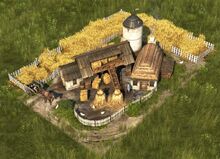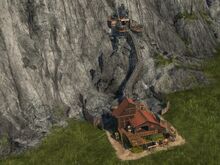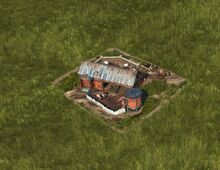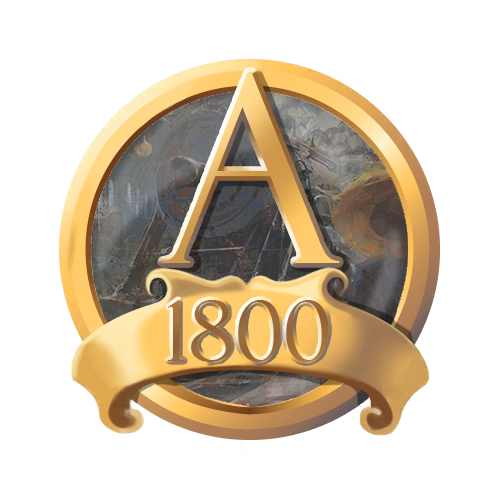Each region in Anno 1800 has its own set of fertilities and resources, which are randomly assigned to the islands present there. The amount of fertilities and resource deposits available, depends on difficulty settings.
A detailed summary can be brought up by hovering the player's view over an island. A series of icons above the minimap will summarize the availability of fertilities and the number of resource deposits on the island. Clicking the icons of the resources, will cause the view to center on their locations.
A more general overview of an island's fertilities and resources is displayed when hovering the cursor over islands in the trade route menu.
Fertilities[]

A Grain Farm produces  Grain when placed on an island with the grain fertility.
Grain when placed on an island with the grain fertility.
Fertilities in the context of Anno 1800, refer to islands having the ability to support the growth and/or harvesting of a specific organic material. Production buildings that are designed to exploit these fertilities, need them to function and won't produce anything without them. There's a wide variety of fertilities and buildings too:
- Farms make use of crop fertilities to place their fields in any shape the player desires, as long as the field tiles are adjacent.
- Forest buildings, like the Lumberjack's Hut and Hunting Cabin, make use of weald fertilities like trees and fur to hunt or lumber the woodland life in a small radius directly around them. If these are not initially placed within a forested area, these buildings will seed their own forests and take a while to get started.
- Harbour buildings exploit aquatic fertilities and don't need additional tiles besides their own building to function.
The rule for fertilities, as opposed to resources, is that fertilities have no specific deposit or area where they need to be exploited. If an island has the correct fertility, the farms can grow the crop, the forest posts can hunt the animal, and the harbour buildings can fish for the material anywhere the player would like them upon the island in question. Most of these buildings - like farms and posts - do need a large amount of surface space to work however and the player might quickly find themselves running out of room on smaller islands. Impeding upon or limiting such a building's work space, will decrease its productivity. Harbour buildings have another problem in that they're build upon a limited amount of coastline.
If an island doesn't have a certain crop fertility the player might want, it is still possible to force an island to adapt a fertility. There are three ways of accomplishing that, two of which require a DLC:
- Trade Union or Harbourmaster's Office items: obtain the desired fertility in a small radius around the trade union (or harbourmaster's office) by equipping it with certain seed items. The building itself has to be built within this radius, while any of its farming fields may be placed beyond the reach of the trade union.
- Botanical Garden - requiring
 Botanica DLC - some botanical garden sets can also force an island to adapt fertilities, not all of them can be obtained though. The fertility will be island-wide, meaning that the production building and fields can be placed anywhere on the island.
Botanica DLC - some botanical garden sets can also force an island to adapt fertilities, not all of them can be obtained though. The fertility will be island-wide, meaning that the production building and fields can be placed anywhere on the island. - Research - requiring
 Land of Lions DLC - allows to change an island's fertility to any other fertility belonging to the same region. Each fertility change requires a permit obtained upon researching a "Change Fertility" discovery under the Mastery of Nature section in Major Discoveries. Changing back a fertility to its original element does require another permit. There is no limit on how many times a fertility can be changed, as long as you have researched enough permits.
Land of Lions DLC - allows to change an island's fertility to any other fertility belonging to the same region. Each fertility change requires a permit obtained upon researching a "Change Fertility" discovery under the Mastery of Nature section in Major Discoveries. Changing back a fertility to its original element does require another permit. There is no limit on how many times a fertility can be changed, as long as you have researched enough permits.
| Regional Fertilities | |
|---|---|
Resources[]

Resources in the context of Anno 1800, refer to an island possessing certain mineral or fossil fuel deposits. Production buildings that are designed to exploit these fertilities, need them to function and and cannot be placed without them.
- Mineral ores are exploited by building mines on the side of a mountain where a vein or deposits of the resource exists.
- If the soil has the consistency of clay, quarries can be placed upon the field.
- Fossil fuels are exploited by building a refinery. Refineries have a radius in which pumps can be placed atop underground wells of the fuel.
The rule for resources, as opposed to fertilities, is that resources are only found as a specific, predetermined amount of deposits, upon which only one building can be placed, capable of extracting it. This means that - aside from building the infrastructure necessary to support the mine, quarry or refinery - the exploitation of resources does not take up a lot of space. Since the number of deposits is limited however, the player's ability to exploit resources is relatively finite.
Research (requiring ![]() Land of Lions DLC) allows to move clay deposits or oil springs within the same island, in Old World/Cape Trelawney and New World regions. It also allows to change mountain mine's deposit ore in Old World and Cape Trelawney. Three kinds of permits are needed for these actions to be performed: each permit can be researched under the Mastery of Nature section in Major Discoveries (Move Clay Deposit, Move Oil Spring and Change Deposit Ore). There is no limit on how many times a deposit/spring can be moved and a mine's ore can be changed, as long as you have researched enough permits.
Land of Lions DLC) allows to move clay deposits or oil springs within the same island, in Old World/Cape Trelawney and New World regions. It also allows to change mountain mine's deposit ore in Old World and Cape Trelawney. Three kinds of permits are needed for these actions to be performed: each permit can be researched under the Mastery of Nature section in Major Discoveries (Move Clay Deposit, Move Oil Spring and Change Deposit Ore). There is no limit on how many times a deposit/spring can be moved and a mine's ore can be changed, as long as you have researched enough permits.
| Regional Resources | |
|---|---|
Region Abundances[]

Region-wide abundances are fertilities and resources that the game doesn't mention islands as having, since they're not remarkable. All islands within the region possess these. Players can build the associated buildings in any spot within the region that's valid for construction, and the building will function just fine as long as all its other conditions are met.
| Regional Abundances | |
|---|---|



